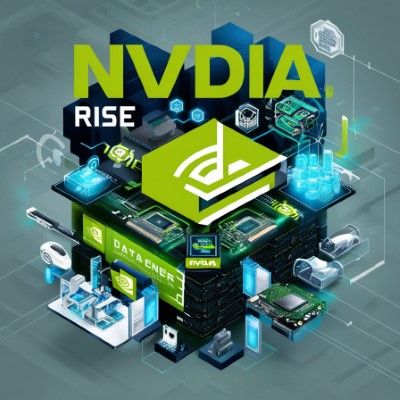Nvidia‘s rise to becoming a leading company, surpassing giants like Apple and Google in certain respects, can be attributed to several strategic moves and market trends. Here are the key factors that contributed to Nvidia’s success:
Nvidia’s Rise: Key Factors
1. Focus on AI and Machine Learning:
- GPU Technology: Nvidia’s GPUs (Graphics Processing Units) are highly efficient at parallel processing, making them ideal for AI and machine learning tasks. The company’s early investment in developing and optimizing GPUs for these applications positioned it as a leader in the AI hardware market.
- CUDA Platform: Nvidia developed CUDA (Compute Unified Device Architecture), a parallel computing platform and application programming interface (API) model. This made it easier for developers to leverage Nvidia GPUs for a wide range of computationally intensive tasks.
2. Data Center Growth:
- AI and Cloud Services: The explosion of AI, cloud computing, and data analytics drove demand for high-performance computing. Nvidia’s GPUs became critical components in data centers, fueling growth in this segment.
- Partnerships with Major Cloud Providers: Nvidia partnered with leading cloud service providers like Amazon Web Services (AWS), Microsoft Azure, and Google Cloud, embedding its technology deeply into the backbone of the modern internet.
3. Expansion into New Markets:
- Automotive Industry: Nvidia expanded into the automotive sector with its DRIVE platform, which powers autonomous vehicles and advanced driver-assistance systems (ADAS).
- Gaming Industry: Nvidia’s dominance in the gaming industry with its GeForce GPU line has been a consistent revenue driver. The introduction of technologies like ray tracing with its RTX series further solidified its market leadership.
4. Strategic Acquisitions:
- Mellanox Acquisition: In 2020, Nvidia acquired Mellanox Technologies, a leading supplier of high-performance networking solutions. This acquisition strengthened Nvidia’s position in the data center market.
- ARM Acquisition: Nvidia announced its intention to acquire ARM Holdings, a leading semiconductor and software design company. Although this acquisition faced regulatory hurdles, it underscored Nvidia’s ambition to expand its influence across various segments of the semiconductor market.
5. Innovative Product Development:
- DLSS and AI-Powered Graphics: Nvidia developed Deep Learning Super Sampling (DLSS), which uses AI to produce higher-resolution images from lower-resolution inputs in real time, enhancing gaming performance and visual quality.
- Nvidia Omniverse: Nvidia’s Omniverse platform for 3D simulation and collaboration offers groundbreaking capabilities for various industries, from entertainment to manufacturing.
6. Strong Financial Performance and Market Perception:
- Stock Performance: Nvidia’s stock price has seen significant appreciation due to strong financial performance, driven by revenue growth in gaming, data centers, and professional visualization.
- Market Valuation: Investor confidence in Nvidia’s strategic direction and growth potential has propelled its market valuation, making it one of the most valuable tech companies in the world.
7. Adapting to Industry Trends:
- Cryptocurrency Boom: The rise of cryptocurrency mining significantly boosted demand for Nvidia GPUs, although the company has had to navigate the volatility of this market.
- AI Adoption Across Industries: As AI adoption accelerated across various industries, from healthcare to finance, Nvidia’s technology became increasingly essential, driving widespread adoption and integration.
Conclusion
Nvidia’s success is a combination of innovative technology, strategic market expansion, and a keen understanding of emerging trends. By capitalizing on the growing demand for AI and high-performance computing, Nvidia positioned itself as a critical player in multiple industries, allowing it to surpass traditional tech giants like Apple and Google in specific domains.
